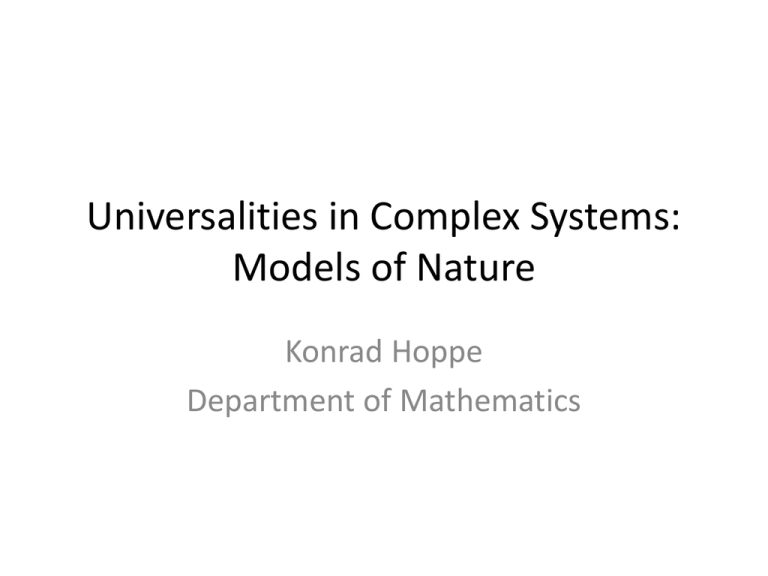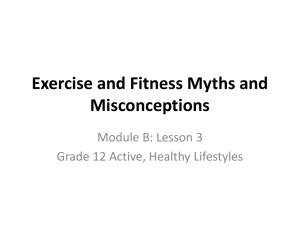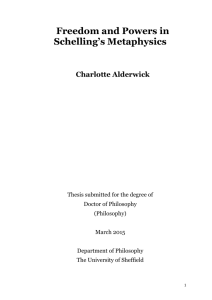the slides
advertisement

Universalities in Complex Systems: Models of Nature Konrad Hoppe Department of Mathematics Universalities - Albeit the complexity of the systems under investigation, one of the main goals is to find Universalities - Curiously, one can find many of these... - In this talk, I will present - Examples of universal patterns - Reasons for their existence - Various modelling attempts Fibonacci Sequence - Motivated in 1202 by Leonardo of Pisa (aka Fibonacci) for rabbit populations - Assume there exists one pair of rabbits (one male, one female) - After one month each pair mates and each female produces one pair (f & m) - How many rabbit pairs exists after one year? - 1, 1, 2, 3, 5, 8, 13, 21,... - The sequence follows a simple rule: Fibonacci Sequence - For Rabbit populations unrealistic - No death - Always pairs of female and male - However, frequently found in nature (www.goldenratiomyth.weebly.com) (www.fractalfoundation.org) Fibonacci Sequence - The sunflower spirals are created by starting in the middle and placing seeds by rotating about a constant angle of 360/1.618 degrees before placing the next seed - 1.618 is a special number, it is the Golden Ratio - Directly related to the Fibonacci numbers - This placing is optimal in terms of space usage! Self Similar Romanesco Broccoli - Spirals - Self Similarity - Zooming in shows similar structures on each level - Again, very rich macroscopic structure - Also self similarity can be explained with simple tools Self Similarities in Mathematics - The Mandelbrot Set - Described by all c, for which the sequence is bounded - The Mandelbrot set is self-similar around certain points, for example around (-1.40115…,0) Social Segregation - Our cities are segregated (www.blogs.lse.ac.uk) Example of London Can we understand this? Yes! Cellular Automata are a powerful tool, to model 2D evolution Cellular Automata - Rules are defined Moore neighbourhood depending on the neighbourhood of a cell - Cells are usually binary: on/off - E.g. If every cell around a given cell is switched Von Neumann neighbourhood on, then switch this cell off Schelling’s Model of Segration - Two groups, ethnicities, classes,… - Define a critical threshold F*, such that if the fraction of neighbours from the owngroup is <F*, then move to a free space - Schelling did the experiment with coins on a grid (1974): Schelling’s Model of Segregation - Separation of two phases: - F<1/3: Random initial configuration remains random - F>1/3: Random configuration converges to a segregated pattern Cellular Automata in Nature - A simple Automaton is defined in 1D - State of a cell depends on its previous value and the cells with offset -1,+1 - The rules are of the form (1,0,1) -> 1, (1,1,1) -> 0 - Since there are 23 =8 possible pattern in a neighborhood - Since each rule leads either to 1 or 0, there are 28 = 256 possible rules Cellular Automata in Nature - Rule 30 is considered to be interesting 111 110 101 100 011 010 001 000 0 0 0 1 1 1 1 0 Complex Networks - Networks are complex structures that are mostly self organized - Albeit their very heterogeneous structures, also here universalities can be found Snapshot of the internet (www.newmedialab.cuny.edu) Complex Networks - The degree distribution P(k) states the probability that a randomly chosen node has k neighbours - Many real-world networks have power law degree distributions: 𝑃 𝑘 = 𝐴𝑘 −𝑎 The structure and function of complex networks, Newman (2003) Complex networks - If we understand the underlying principles that give rise to these universal patterns - Then we can maybe alter network structures - My interest is in fitness dependent networks - Each node is endowed with a static fitness value x - Links in the networks are formed according to some function f(x,y) - 𝑓 𝑥, 𝑦 = 1 - 𝑓 𝑥, 𝑦 = 𝑥𝑦 - 𝑓 𝑥, 𝑦 = 𝑥 − 𝑦 - If we can understand network connectivity in terms of f(x,y) then we can understand also more complicated aspects - Because just one function gives rise to all aspects of the network - First thing: Check whether we can describe topology P(k) in terms of f(x,y) World trade network internals Fitness density Degree density Fitness conditional degrees. Model vs. reality Degree density from fitness model The degree distribution • Central quantity is the fitness and entry time conditional degree distribution • Evolves as • Where lambda is an attractor in terms of f(u,w) • Solution can be found using generating functions Cascading failures • Exposure to failures in the neighbourhood lead to own failure • Fitness describes… – attractiveness – resilience • This coupling makes sense! – Interbank lending markets • The attractiveness of a partnership is coupled to its possible endurance • Exposure runs against edge direction Cascading failures cont’d. • • • • A node fails if a critical fraction of its neighbours has failed This critical fraction is the node’s fitness A node is vulnerable if x < 1/k Using previous technology, we know the fitness conditional degree distribution p(k|x) • This leads to the probability that a randomly chosen node has degree k and is vulnerable • And finally the percolation threshold Size of the vulnerable component • • What is the effect of… • different fitness distributions? • different attachment kernels? • different network densities? This knowledge is valuable to policy makers and regulators








